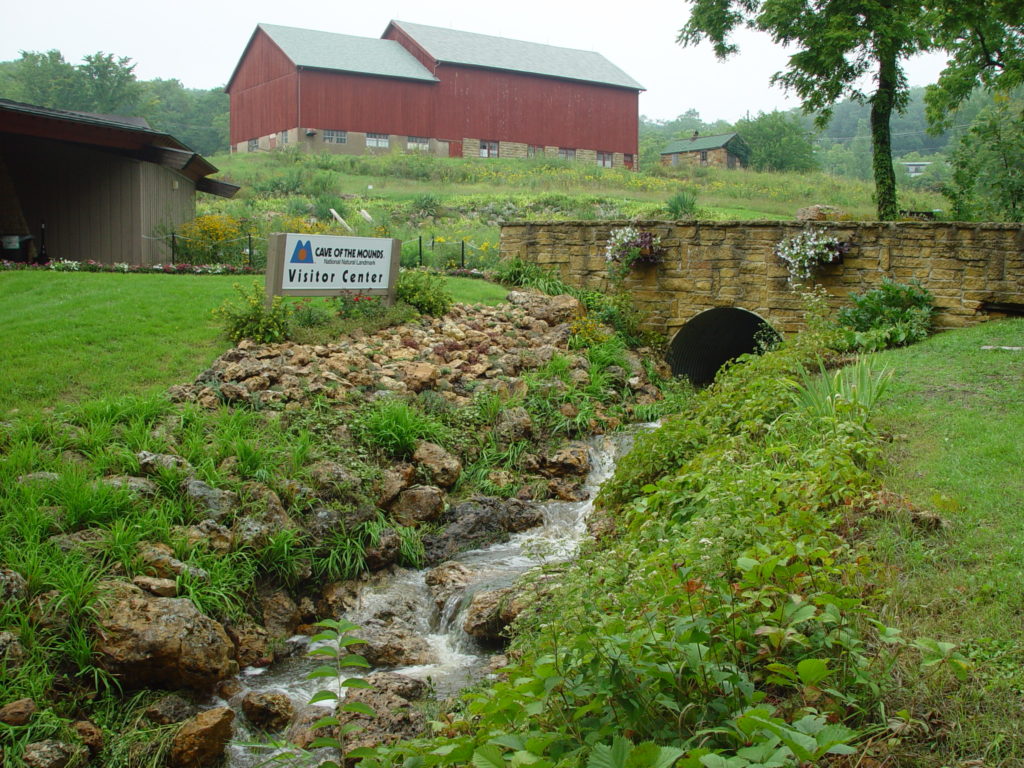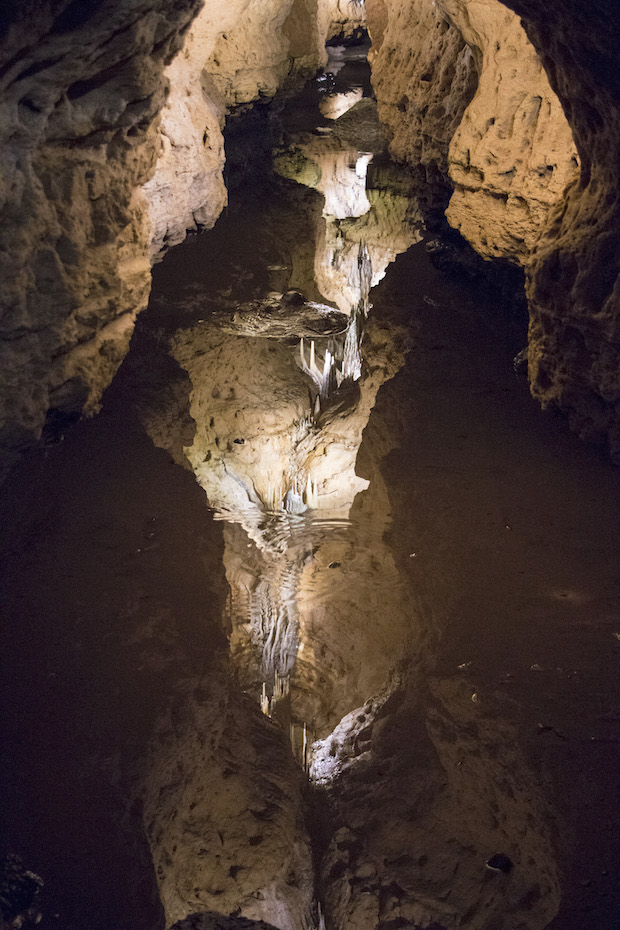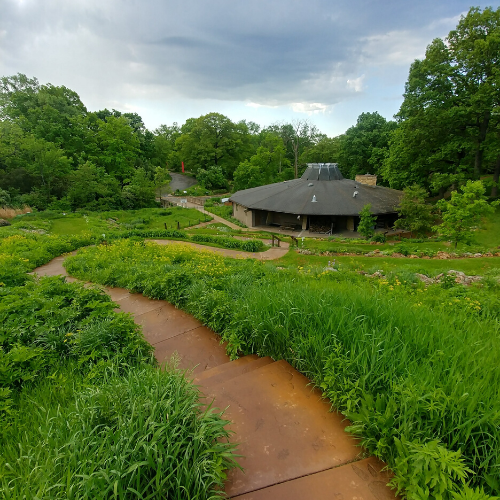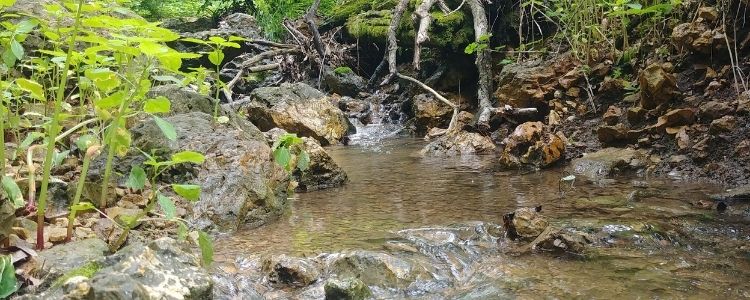The Importance of Water
Written by Stalac-Tate, with help from hydrologist Catherine
Water is something we use every day. Whether it’s taking a shower, cooking a meal, or just drinking it, water is important to our survival as human beings. However, there is so much about water that we may not know about, especially the importance of water.
Let’s start with the important question, what is water? There are several ways that we can think about water, such as a chemical molecule, the force of nature, and the necessity of life.
Water, at its simplest, is a molecule made of two hydrogen atoms that are attached to an oxygen atom, or H2O for short. This is its chemical formula. Because of this structure, water is very good at dissolving or breaking down other things, better than anything else! This is why water is called the universal solvent. This is also why water often has other things in it.


Here at Cave of the Mounds, water is responsible for forming the cave! We often think about the importance of water. It has dissolved parts of the limestone rock, leaving the cave behind! The reason why water is so good at dissolving other materials is because of its polar structure. These positive and negative forces attract opposite forces of other molecules, much like a magnet. This can also affect the pH of the water or its acidity/alkalinity. H20 splits into a positive H+ (hydrogen) ion and a negative OH- (hydroxide) ion, which attracts oppositely charged ions and molecules to dissolve substances. But sometimes an excess of H+ or OH- ions build up. Extra H+ makes the water more acidic; extra OH- makes the water more basic.
Water can also exist in several different forms, known as states: solid, liquid, and gas. We recognize these as ice, water, and clouds. The states are dependent upon how much energy (kinetic and thermal) the water has and how many water molecules (H2O) are squeezed into space (density). Typically, the more energy, the more spread out the molecules. The less energy, the more compact. A way to think about this is like a playground. Kids have a lot of energy and they want a lot of space to move and run. However, when kids have little energy, they can sit quietly in a small group.
But water is unique because ice (solid) is less dense than liquid water. Water expands about 9% when it freezes, which is why it floats. This is because water is polar; ice is a rigid framework of H2O molecules, while liquid has the molecules sliding past one another.
So that’s what water is made of; now let’s explore what it can do. A wave or current of water can be pretty powerful. This is why water is also thought of as a force of nature, meaning it can change and shape the landscape features through weathering and erosion. This means it can break down rock and other materials, and move them. As we just learned, water can chemically dissolve materials, but the physical force of water can also break things apart and move them. This has happened to the cave too!


Another way water as a force is by influencing the weather in different parts of the world! There’s a lot it can do to shape the world.
- weathering – the breakdown of rock or other materials into smaller pieces
- erosion – physical transport of other materials by water
- weather – short-term temperature and precipitation (how hot/cold and how wet/dry)
Last, but not least, water is also a necessity of life, as everything needs it to survive. Truly the importance of water is daily thought about for survival. In this way, it affects what plants and animals live in certain places. Because everything needs water, it also acts as a connection between all things on Earth. Since there is a set amount of water here on Earth, water is recycled and reused. Some of the water we drink today was drunk by the dinosaurs!
Now that we’ve talked about what water is, let’s talk about where to find it. Much of the Earth is covered in water, and about 71% of the Earth’s surface is water. There’s so much we can see easily from space. Earth is unique because it is the only planet in our solar system that we know has liquid water (though the Moon and Mars have ice, and some moons of Jupiter might have liquid water). All the water on Earth is collectively called the “hydrosphere,” which means “water ball.” But where do we find most of the water on Earth?
In the oceans! 97% of Earth’s water is found in the oceans. Fun fact: the oceans contain about 90% of all life on Earth! We can’t drink all the saltwater from the oceans, we need fresh water to drink, and it accounts for only 3% of all water. But we can’t access or use it all. Most of it is stored in glaciers and ice, and some are stored underground. Only 1% of fresh water is easily accessible, and only about half of that is contained in rivers and lakes. So some types of water are pretty rare! Other places water can be found are in clouds and within animals and plants. For example, the human body is comprised of about 70% water.
Not all places have lakes and rivers and other environments, water can be found so easily. This means different areas on Earth have different amounts of water. The amount of water in different regions is influenced by how water moves and is transported, which is called “the water cycle!” This cycle is driven by energy from the Sun, which causes water to move between these areas in different states as it gains or loses energy. For example, liquid water in an ocean or lake can evaporate to become water vapor, or gas, when heated by the Sun. The water vapor then cools high in the sky and condenses into clouds. Eventually, the water gets too heavy in the clouds, and it precipitates. Precipitation can come in several forms depending on the temperature: rain, sleet, or snow. Similarly, plants and animals can transpire/sweat water into gas; this keeps the organisms from getting too hot. Water can also freeze to become solid ice, and then melt to return to liquid water. Water can percolate/seep through the soil into underground aquifers of water. Actually, in the cave, you will experience water that has infiltrated the rock and precipitates from the ceiling! This is called a cave kiss!
This transference of energy through the water cycle also is responsible for moving water around the globe. Clouds are blown by the wind, carrying water to new places. Water can even be moved about within ocean currents, moving warmer or colder water and nutrients to new places. In this way, water shapes climate, or the long-term weather patterns of a region.
The water cycle happens on many scales or sizes. The importance of water is seen all around us. One of the smaller scales is a watershed. A watershed is an area of land where all the water under it or drains off it collects in the same place. High points – hilltops or mountains can act as a boundary for watersheds. This is important because things that occur within the watershed affect the quality of the water, or what is in the water. For example, if an area is cleared, water can carry loose soil into the water. But sometimes things outside a watershed can also affect it. Clouds carry water between watersheds, and people can move water by either pipelines, trucks, or in food that is produced in one place but sold elsewhere. Vice versa, water can be brought into a watershed.


Cave of the Mounds is located in the watershed of the Pecatonica River. This river flows into the Rock River, then to the Mississippi River. And here at Cave of the Mounds, water is very, very important. That is why we talk about the importance of water. Water has helped create and shape the cave, starting over 400 million years ago when the rock formed..let’s take a closer look at how water is a vital part of the cave.
About 400 – 500 million years ago, WI was under a shallow ocean and most of North America. The water was home to sea creatures, many of whom had shells, like the giant cephalopod. When these creatures died, their shells sank to the bottom, and over time became cemented and compacted into layers of limestone rock. Fossils formed from water replacing the original material of the shell with other minerals, literally turning them to stone!
During this period, North America was located at the equator. Wisconsin was south of the equator! It has since shifted due to plate tectonics. So water helped form the limestone, but it also helped form the cave within. Over 1 million years ago, water mixed with carbon dioxide to form carbonic acid, which trickled through cracks in the limestone. The acid ate/dissolved away the limestone, forming cavities…our cave!
And today, water helps form cave formations, also called speleothems. They are formed from a mineral called calcite which water dissolves out of the limestone rock, then deposits in the cave. There are many different types, including stalactites and stalagmites. The formation of these speleothems is a perfect example of water as the universal solvent and as a force of nature.
Water is constantly in our lives. It is the importance of water that drives us. We use a lot of water in our daily lives, about 80-100 gallons each per day. In our homes, the biggest water users are showers and toilets, which use almost half of the total. Washing clothes and dishes also uses a lot of water. The water that we drink accounts for less than 1% of the water we use in a day.
It’s also used outside of the home, in businesses. The majority is used to make electricity and to water crops, which then become food. Speaking of food, did you know that to make all the food one average American adult eats in one day, takes about 1700 gallons of water. That’s a lot of water!
Humans also need to think about the water in terms of weather because sometimes it can be dangerous. The importance of water is realized when we need it the most. These are called natural disasters. Sometimes we get too much water and sometimes not enough.
Unfortunately, humans don’t always clean up after themselves. Sometimes trash and other chemicals get into the water. This is called pollution. Remember how water is a universal solvent? It can be hard to get the pollutant out of water because of this. It is always better and easier to prevent something rather than having to clean it up.
Another form of pollution is too many nutrients (plant food)(eutrophication). This can cause toxic algal blooms that make the lake unswimmable and undrinkable as the algae release toxins that can make animals very sick.
Now that we’ve learned about how we use water, we realize that we have two main problems: not having enough easily accessible freshwater and not having enough clean water. So, what can we do about it? We can conserve water by finding ways to use less of it.
It’s also really important to tell others the importance of water and what you’ve learned so they can also help conserve water.

